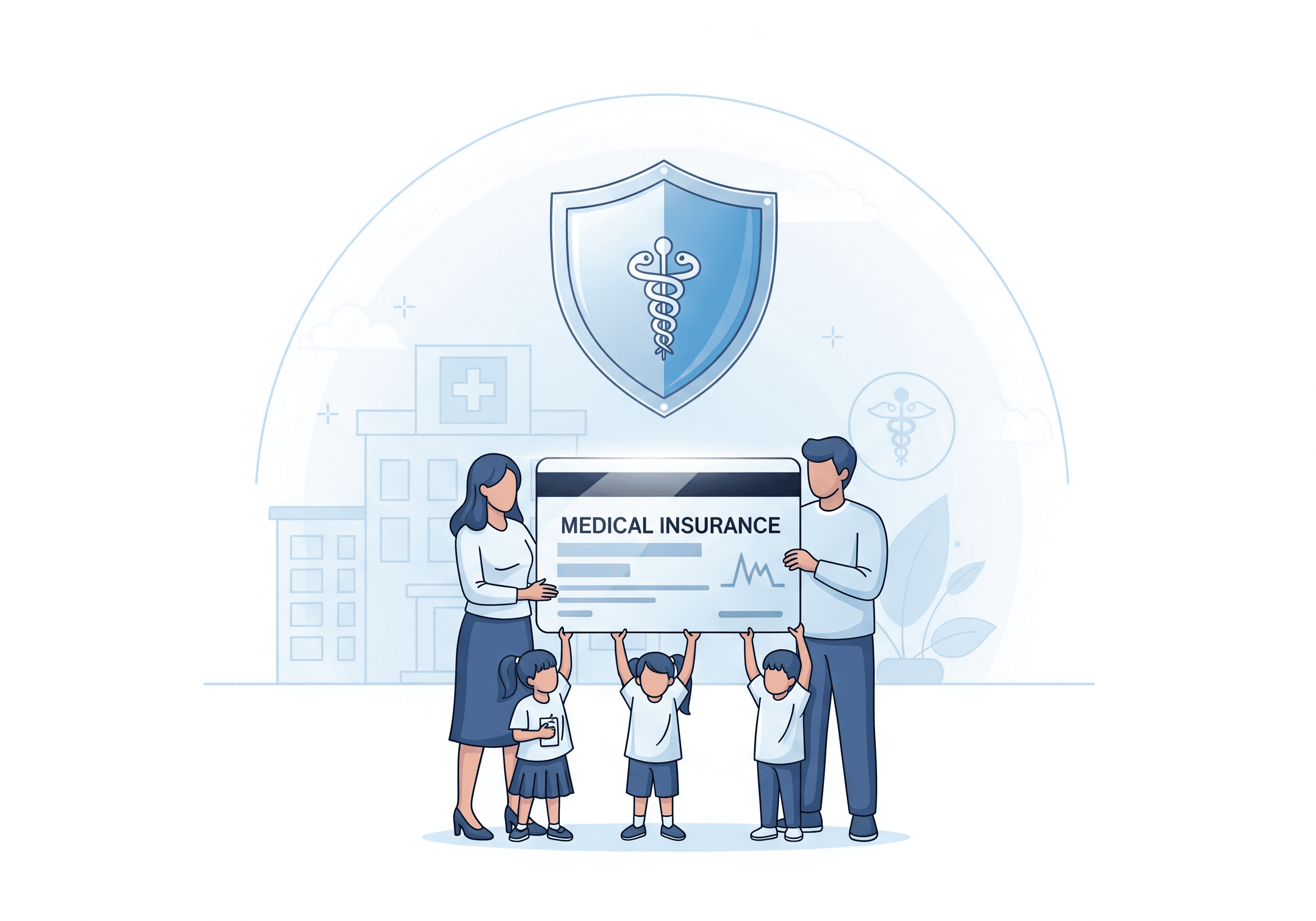Navigating the world of health insurance can feel like learning a new language. Between acronyms like PPO, HMO, and HDHP, and terms like deductibles, copayments, and out-of-pocket maximums, it’s easy to feel overwhelmed. Yet, in a world where an unexpected medical emergency can lead to devastating financial consequences, understanding and securing the right health coverage has never been more critical.
This guide is designed to be your definitive resource for 2025. We will demystify the complexities of health insurance, break down the costs, explore the different types of plans available, and provide a clear, step-by-step process for choosing the coverage that best protects your health and your finances. Whether you’re getting insurance through your employer, buying it on the ACA Marketplace, or exploring government programs like Medicare, this guide will equip you with the knowledge to make confident and informed decisions for the year ahead.
Why Health Insurance is Essential in 2025
Think of health insurance as a financial and physical safety net. While we all hope for a year of perfect health, life is unpredictable. A sudden illness, a broken bone, or the diagnosis of a chronic condition can happen to anyone. Without insurance, the cost of treatment can be astronomical, leading to significant debt for many families. Here’s why having a solid health plan in 2025 is non-negotiable.
Financial Protection from Catastrophic Costs
The primary function of health insurance is to protect your savings and assets from the high cost of medical care. A single hospital stay can cost tens of thousands of dollars, while treatment for a major illness like cancer can easily run into the hundreds of thousands. Health insurance limits your financial liability to a more manageable amount, defined by your deductible and out-of-pocket maximum. It’s the barrier standing between you and potentially life-altering medical debt.
Access to Necessary and Preventive Care
Having health insurance fundamentally changes how you interact with the healthcare system. Instead of avoiding the doctor due to cost concerns, you are more likely to seek care when you need it. Crucially, all plans compliant with the Affordable Care Act (ACA) cover a range of preventive services at no cost to you. This includes annual check-ups, vaccinations, and screenings for conditions like cancer and diabetes. Early detection and prevention are key to better health outcomes and lower long-term healthcare costs.
Management of Chronic Conditions
For millions of people living with chronic conditions such as asthma, heart disease, or diabetes, ongoing medical care is a necessity. Health insurance makes managing these conditions affordable. It covers regular doctor visits, necessary tests, and, most importantly, the prescription drugs required to maintain health and quality of life. Without it, the consistent costs could become an insurmountable burden.
Peace of Mind
Beyond the financial and physical benefits, the psychological comfort of knowing you are covered is invaluable. Health insurance provides peace of mind, allowing you to live your life without the constant worry of what might happen—and how you would pay for it—if you or a family member gets sick or injured. This security allows you to focus on what matters most: your health and recovery.
Decoding Health Insurance Terminology: The Core Concepts
To choose the right plan, you first need to understand the language of health insurance. The costs associated with your plan can be broken down into a few key terms. Let’s think of it like a tiered payment system you agree to when you sign up.
1. Premium
A premium is the fixed amount of money you pay regularly (usually monthly) to the insurance company to keep your health plan active. It’s like a subscription fee. You must pay your premium every month, regardless of whether you use any medical services. This is the baseline cost of your insurance.
2. Deductible
The deductible is the amount of money you must pay out-of-pocket for covered medical services before your health insurance company starts to pay. For example, if your plan has a $2,000 deductible, you are responsible for the first $2,000 of your covered healthcare costs for the year. Preventive services are typically covered before you meet your deductible. Plans with lower monthly premiums often have higher deductibles, and vice versa.
3. Copayment (Copay)
A copayment, or copay, is a fixed amount you pay for a specific covered health care service after you’ve met your deductible. For instance, your plan might require a $30 copay for a visit to your primary care doctor or a $250 copay for an emergency room visit. Copays are a form of cost-sharing that makes you aware of the cost of care each time you use a service.
4. Coinsurance
Coinsurance is the percentage of the cost of a covered health service that you are responsible for paying after you have met your deductible. For example, if your plan has a 20% coinsurance rate, and you receive a medical bill for $1,000 after your deductible has been met, you would pay 20% of the bill ($200), and the insurance company would pay the remaining 80% ($800).
5. Out-of-Pocket Maximum
This is arguably the most important number for your financial safety. The out-of-pocket maximum is the absolute most you will have to pay for covered services in a single plan year. After you have spent this amount on deductibles, copayments, and coinsurance, your health insurance plan will pay 100% of the cost of all covered benefits for the rest of the year. This feature provides a critical cap on your annual medical spending, protecting you from catastrophic costs in the event of a major illness or injury. Your monthly premiums do not count toward this limit.
Let’s see it in action with an example:
Imagine your plan has the following structure:
- Premium: $400/month
- Deductible: $3,000
- Coinsurance: 20%
- Out-of-Pocket Maximum: $7,000
In March, you have a minor surgery that costs $12,000. Here’s how the payment would break down:
- You pay the deductible first: You are responsible for the first $3,000.
- Calculate the remaining bill: $12,000 (total cost) – $3,000 (your deductible) = $9,000.
- Calculate your coinsurance: You pay 20% of the remaining $9,000, which is $1,800. Your insurer pays the other 80% ($7,200).
- Total you’ve paid so far: $3,000 (deductible) + $1,800 (coinsurance) = $4,800.
- Amount left to reach your out-of-pocket maximum: $7,000 (max) – $4,800 (paid) = $2,200.
For the rest of the year, you would continue to pay copays and coinsurance until you spend another $2,200. After that point, your insurance would cover everything at 100%.
Types of Health Insurance Plans: Finding Your Fit
Not all health insurance plans are created equal. They differ primarily in how you can access care and how much freedom of choice you have when it comes to doctors and hospitals. The four main types of plans are HMOs, PPOs, EPOs, and POS plans.
HMO: Health Maintenance Organization
HMO plans are designed around a specific network of doctors, hospitals, and healthcare providers. To receive coverage, you generally must use providers within this network.
- Primary Care Physician (PCP): With an HMO, you are typically required to choose a PCP from within the network. Your PCP is your main point of contact for all your healthcare needs.
- Referrals: If you need to see a specialist, such as a cardiologist or a dermatologist, you must first get a referral from your PCP.
- Out-of-Network Care: There is generally no coverage for care received from providers outside the HMO network, except in true medical emergencies.
- Best for: Individuals and families who want lower premiums and are comfortable with coordinated care through a PCP and a limited network.
PPO: Preferred Provider Organization
PPO plans offer the most flexibility when it comes to choosing your healthcare providers.
- Network Flexibility: PPOs have a network of “preferred” providers, and you’ll pay less if you use them. However, you have the freedom to see doctors, specialists, and hospitals that are out-of-network.
- No PCP or Referrals: You are not required to select a PCP, and you can see specialists directly without needing a referral.
- Higher Costs: This flexibility comes at a price. PPO plans typically have higher monthly premiums and you’ll pay more for out-of-network care.
- Best for: People who want the freedom to choose their doctors and specialists without referrals, and who are willing to pay more for that flexibility.
EPO: Exclusive Provider Organization
EPO plans are a hybrid of HMOs and PPOs. They offer a middle ground between cost and flexibility.
- In-Network Only: Like an HMO, you must use doctors, specialists, and hospitals within the plan’s network. There is no coverage for out-of-network care except in emergencies.
- No Referrals Needed: Like a PPO, you do not need to have a PCP or get referrals to see specialists within the network.
- Best for: Individuals who want the cost savings of an HMO but the freedom to see specialists directly without a referral, as long as they stay in-network.
POS: Point of Service
A POS plan combines features of both HMOs and PPOs.
- PCP and Referrals: Like an HMO, you typically need to choose a PCP and get referrals for specialist care.
- Out-of-Network Option: Like a PPO, you have the option to go out-of-network for care, but you will pay significantly more, and you may have to handle the paperwork and pay the provider upfront and get reimbursed later.
- Best for: People who want the option of out-of-network coverage but are willing to coordinate their care through a PCP to keep costs lower.
HDHP: High-Deductible Health Plan
An HDHP is not a separate type of plan but rather a financial structure that can be applied to any of the plan types above (e.g., a PPO-based HDHP).
- High Deductible, Low Premium: As the name suggests, these plans feature a higher deductible than traditional plans. In exchange, the monthly premiums are significantly lower.
- Health Savings Account (HSA): HDHPs are the only plans that can be paired with an HSA, a powerful, tax-advantaged savings account used for medical expenses. (More on this later).
- Best for: Healthy individuals and families who don’t expect many medical expenses and want to save money on premiums while building a tax-free health fund in an HSA.
Plan Comparison at a Glance
| Feature | HMO (Health Maintenance Organization) | PPO (Preferred Provider Organization) | EPO (Exclusive Provider Organization) | POS (Point of Service) |
| Monthly Premium | Lower | Higher | Moderate | Moderate |
| PCP Required? | Yes | No | No | Yes |
| Referrals to Specialists? | Yes | No | No | Yes, for in-network |
| Out-of-Network Coverage | No (except emergencies) | Yes (at a higher cost) | No (except emergencies) | Yes (at a higher cost) |
| Best For | Cost-conscious users who are fine with a limited network. | Users who want maximum flexibility and choice. | Users wanting a balance of cost and direct specialist access. | Users wanting a PCP to coordinate care with some out-of-network options. |
Export to Sheets
Where to Get Health Insurance in 2025
There are several pathways to obtaining health insurance coverage. The right one for you depends on your employment status, income, age, and other life circumstances.
1. Through an Employer (Group Insurance)
For most Americans, this is the most common source of health coverage. Companies purchase group plans and offer them to their employees as part of a benefits package.
- Advantages: Employers typically cover a significant portion of the monthly premium, making it a more affordable option. It’s also easy to enroll during your hiring process or the company’s annual open enrollment period.
- Considerations: Your choice of plans is limited to what your employer decides to offer. If you leave your job, you will lose this coverage, though you will be eligible to continue it for a period through COBRA (which is often very expensive) or enroll in a Marketplace plan.
2. The Health Insurance Marketplace (ACA / “Obamacare”)
Created by the Affordable Care Act, the Health Insurance Marketplace (found at HealthCare.gov or your state’s specific exchange website) is designed for people who are self-employed, unemployed, or work for a company that doesn’t offer affordable health insurance.
- Metal Tiers: Plans on the Marketplace are categorized into four “metal” tiers: Bronze, Silver, Gold, and Platinum. These tiers have nothing to do with the quality of care, but rather how you and your insurer share costs.
- Bronze: Lowest monthly premium, but the highest out-of-pocket costs when you need care.
- Silver: Moderate monthly premium and moderate out-of-pocket costs. Crucially, only Silver plans are eligible for Cost-Sharing Reductions.
- Gold: High monthly premium, but low out-of-pocket costs.
- Platinum: Highest monthly premium and the lowest out-of-pocket costs.
- Subsidies: The Marketplace is the only place you can receive government financial assistance to lower your costs.
- Premium Tax Credit: This subsidy lowers your monthly premium. Eligibility is based on your household income.
- Cost-Sharing Reductions (CSRs): These extra savings lower your deductible, copayments, and out-of-pocket maximum. You must have a qualifying income and choose a Silver plan to receive CSRs.
3. Government Programs
- Medicare: A federal program primarily for people aged 65 or older, as well as for younger people with certain disabilities or end-stage renal disease. It is divided into several parts: Part A (Hospital Insurance), Part B (Medical Insurance), Part C (Medicare Advantage), and Part D (Prescription Drugs).
- Medicaid: A joint federal and state program that provides free or low-cost health coverage to millions of low-income Americans, including some pregnant women, children, adults, seniors, and people with disabilities. Eligibility rules vary significantly from state to state.
- CHIP (Children’s Health Insurance Program): Provides low-cost health coverage for children in families who earn too much to qualify for Medicaid but cannot afford to buy private insurance.
4. Directly from an Insurer
You can also purchase a health plan directly from an insurance company’s website or through an insurance broker. These are known as “off-exchange” plans. While these plans must still comply with all ACA consumer protections (like covering essential health benefits), you cannot receive any premium tax credits or cost-sharing reductions if you buy a plan this way.
5. Short-Term Health Insurance
Short-term plans are designed as temporary stopgaps for people between coverage, such as after leaving a job or waiting for a new plan to start.
- WARNING: These plans are not ACA-compliant. They are not required to cover essential health benefits, can deny you coverage based on pre-existing conditions, and have annual or lifetime coverage limits. They should only be considered a last resort for brief periods.
The 2025 Health Insurance Landscape: What’s New and Trending
The world of healthcare is constantly evolving. As we look ahead to 2025, several key trends are shaping the insurance landscape and impacting how consumers access and pay for care.
The Permanence of Telehealth
The COVID-19 pandemic accelerated the adoption of telehealth, and it’s here to stay. In 2025, expect most insurance plans to offer robust telehealth benefits, often with lower copays than in-person visits. This provides convenient access to primary care, mental health services, and specialist consultations from the comfort of your home. When comparing plans, look at the scope and cost of their telehealth offerings.
Renewed Focus on Mental Health Parity
There is a growing regulatory and social emphasis on ensuring that coverage for mental and behavioral health is on par with coverage for physical health. The Mental Health Parity and Addiction Equity Act (MHPAEA) requires this, and in 2025, expect continued enforcement and expansion of these benefits. This means plans should not have more restrictive limits on therapy visits or higher copays for mental health services compared to medical services.
Prescription Drug Cost Regulation
Thanks to provisions in the Inflation Reduction Act, changes are underway to control prescription drug costs, particularly for those on Medicare. This includes caps on insulin costs and the ability for Medicare to negotiate prices for certain high-cost drugs. While the most significant effects will be phased in over the next few years, the downward pressure on drug prices is a positive trend for consumers in 2025 and beyond.
Enhanced Price Transparency
New federal rules require hospitals and insurance companies to be more transparent about the prices of their services. In 2025, consumers will have access to better tools to compare the costs of procedures and services between different providers within their network. This empowers you to be a more informed healthcare “shopper” and potentially save money on planned medical procedures.
Step-by-Step Guide: How to Choose the Right Health Insurance Plan in 2025
Choosing a health plan is a major financial decision. Follow these steps to select a plan that fits your health needs and your budget.
Step 1: Assess Your Healthcare Needs and Budget
First, take stock of your personal situation.
- Health Status: Are you generally healthy and only see a doctor for annual check-ups? Or do you have a chronic condition that requires regular visits, tests, and medication? Are you planning a major life event, like having a baby? Your anticipated medical needs will heavily influence the type of plan you should choose. A healthy person might do well with a low-premium, high-deductible plan, while someone with a chronic illness might be better off with a Gold plan that has lower out-of-pocket costs.
- Budget: Determine what you can comfortably afford for a monthly premium. Then, consider how much you could realistically pay out-of-pocket if you had a medical emergency. This will help you find the right balance between premiums and deductibles.
Step 2: Check for Your Doctors, Hospitals, and Specialists
This is a critical step. A plan is only as good as the doctors and hospitals it allows you to see.
- Use the Provider Directory: Before you enroll in any plan, use the insurance company’s online provider directory to check if your current doctors, preferred hospitals, and any specialists you see are “in-network.”
- Call to Confirm: It’s always a good idea to call your doctor’s office directly and ask which specific insurance plans they will accept in 2025. Provider networks can change from year to year. Do not assume your doctor is covered just because they took a similar plan last year.
Step 3: Check Your Prescription Drugs
If you take medications regularly, ensuring they are covered is essential.
- Review the Formulary: Each insurance plan has a list of covered prescription drugs called a “formulary.” Check this list to make sure your medications are included.
- Look at Drug Tiers: Formularies are often divided into tiers. Generic drugs (Tier 1) will have the lowest copay, while brand-name (Tier 2/3) and specialty drugs (Tier 4) will cost significantly more. See which tier your medications fall into to estimate your annual drug costs.
Step 4: Compare Total Costs, Not Just the Premium
The plan with the lowest monthly premium is not always the cheapest overall. You must estimate your total annual healthcare cost.
- Do the Math: For each plan you’re considering, calculate the following:
(Monthly Premium x 12) + Annual Deductible + Estimated Copays/Coinsurance = Total Estimated Annual Cost - Compare Scenarios: Run this calculation for a “healthy year” (low medical usage) and a “sick year” (high medical usage, reaching the out-of-pocket max). This will give you a much clearer picture of your potential financial exposure with each plan. A Silver plan with a higher premium might actually save you thousands of dollars in a sick year compared to a Bronze plan, especially if you qualify for cost-sharing reductions.
Step 5: Don’t Miss the Enrollment Deadlines
You can only enroll in a new health plan during a specific window each year.
- Open Enrollment: This is the main period when anyone can sign up for coverage. For the ACA Marketplace, it typically runs from November 1 to January 15 in most states. Employer open enrollment periods vary but are usually in the fall.
- Special Enrollment Period (SEP): If you experience a “qualifying life event,” you may be eligible to enroll in a plan outside of the open enrollment window. These events include getting married, having a baby, moving, or losing other health coverage (like leaving a job). You usually have 60 days from the event to enroll.
Maximizing Your Benefits: HSAs and FSAs
Health Savings Accounts (HSAs) and Flexible Spending Accounts (FSAs) are tax-advantaged accounts that can help you pay for medical expenses and save money.
Health Savings Account (HSA)
An HSA is a personal savings account that you can use for qualified medical expenses.
- Eligibility: You must be enrolled in a High-Deductible Health Plan (HDHP) to be eligible to contribute to an HSA.
- The Triple Tax Advantage: This is what makes HSAs so powerful.
- Contributions are tax-deductible: The money you put in lowers your taxable income for the year.
- The money grows tax-free: You can invest your HSA funds, and any earnings are not taxed.
- Withdrawals are tax-free: You can take money out at any time to pay for qualified medical, dental, and vision expenses without paying taxes.
- Ownership: The money in your HSA is yours forever. It rolls over year after year (it’s not “use it or lose it”), and you take it with you even if you change jobs or insurance plans.
Flexible Spending Account (FSA)
An FSA is an account offered through an employer that allows you to set aside pre-tax dollars for medical expenses.
- How it Works: You decide how much to contribute for the year, and that amount is deducted from your paychecks before taxes are calculated, reducing your overall taxable income.
- “Use It or Lose It”: The key difference from an HSA is that FSA funds generally must be spent within the plan year. Many employers offer a grace period or allow you to carry over a small amount (around $640 for 2024, likely similar for 2025) to the next year, but you can forfeit any unused funds beyond that.
Beyond the Basics: Dental and Vision Insurance
Standard health insurance plans typically do not cover routine dental or vision care for adults. These benefits are usually sold as separate policies or as an add-on “rider” to a health plan.
- Dental Insurance: These plans often focus on preventive care, covering 100% of the cost of cleanings and check-ups. They then typically cover a percentage of the cost for other services, such as 80% for basic procedures like fillings and 50% for major procedures like crowns or root canals. Most plans have an annual coverage maximum (e.g., $1,500 per year).
- Vision Insurance: Vision plans provide benefits for eye exams, eyeglasses (lenses and frames), and contact lenses. They typically offer a fixed allowance or discount on these items and services.
Is it worth it? If you anticipate needing more than just a routine cleaning and eye exam, these plans can be very cost-effective. Calculate the annual premium versus your expected needs to see if it makes sense for you.
Frequently Asked Questions (FAQ)
Q1: What happens if I miss the Open Enrollment deadline? If you miss the deadline and do not have a qualifying life event for a Special Enrollment Period, you will likely have to wait until the next Open Enrollment period to get an ACA-compliant plan. You may be able to purchase a short-term health plan to bridge the gap, but be aware of their significant limitations.
Q2: Can an insurer deny me coverage because of a pre-existing condition? No. Under the Affordable Care Act, it is illegal for an insurance company to deny you coverage, charge you more, or refuse to pay for essential health benefits for any pre-existing condition, such as asthma, diabetes, or cancer.
Q3: Is short-term health insurance a good substitute for a regular plan? Generally, no. Short-term plans are meant only for temporary gaps in coverage. They are not regulated by the ACA, can deny claims for pre-existing conditions, do not have to cover essential benefits like maternity care or prescription drugs, and have caps on how much they will pay out. They are not a reliable substitute for comprehensive health insurance.
Q4: How do I find out for sure if my doctor is in-network? The best way is to use a two-step verification process. First, use the insurer’s online provider search tool for the specific plan you are considering. Second, call your doctor’s billing office directly. Give them the exact name of the health plan (e.g., “Blue Cross Blue Shield Gold PPO Plan XYZ”) and ask if they are a participating provider for 2025.
Conclusion
Choosing a health insurance plan is one of the most important decisions you will make for yourself and your family. By understanding the key terms, comparing the different plan types, and carefully assessing your unique health and financial needs, you can move from a place of confusion to one of confidence. Health insurance is more than just a monthly expense; it’s a vital investment in your long-term health, financial security, and overall peace of mind. Don’t wait for a medical emergency to strike. Use this guide to do your research, ask the right questions, and select a 2025 plan that truly has you covered.












📟 🔐 Security Pending: 1.3 BTC deposit on hold. Confirm now >> https://graph.org/ACQUIRE-DIGITAL-CURRENCY-07-23?hs=bdfe746ba628839682f79434ffc80648& 📟
b6e6nl